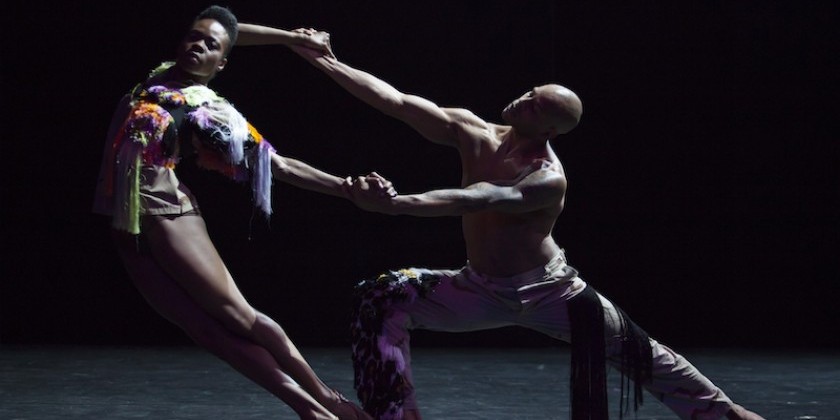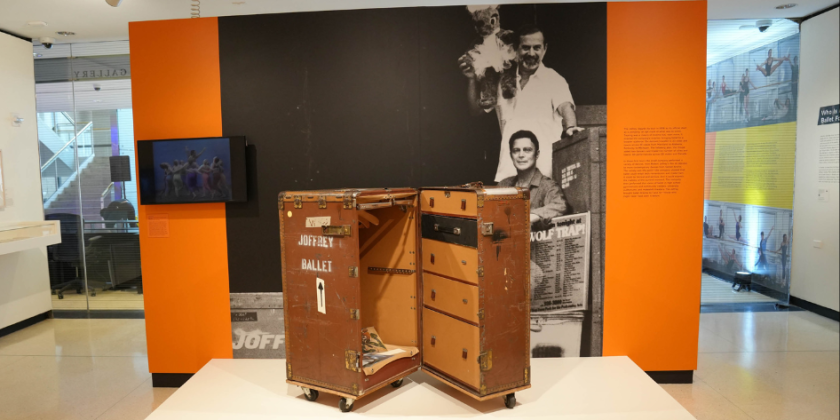IMPRESSIONS OF: Cedar Lake Contemporary Ballet /The Goodbye Season

Dance Interrupted
Cedar Lake Contemporary Ballet ,BAM Howard Gilman Opera House
June 3 to 6, 2015
Works by Johan Inger, Jiří Kylián, Crystal Pite, Richard Siegal and Jo Strømgren
Dancers: Jon Bond, Nickemil Concepción, Joaquim de Santana, Vânia Doutel Vaz, Joseph Kudra, Navarra Novy-Williams, Raymond Pinto, Guillaume Quéau, Matthew Rich, Ida Saki, Ebony Williams, Jin Young Won
Apprentices: Patrick Coker, Daphne Fernberger
Artistic Director: Alexandra Damiani
Rehearsal Director: Brian Reeder
“All this will end very badly,” Jacques Derrida predicts during the rambling lecture we hear him deliver in “Necessity, Again,” a dance that Cedar Lake Contemporary Ballet revived as part of its June engagement at BAM’s Howard Gilman Opera House.
The dancers laugh at his words. Why dwell on the end of life, a grim eventuality, when the seductive rhythms of a Charles Aznavour song are here, right now, inviting them to party? Matthew Rich takes things too far when he pursues Ebony Williams, following her and quivering with an urge she finds unsettling. Yet who can argue with the vitality of the others, swishing their hips, exclaiming with bold gestures and assembling jaunty tableaux? Surely life is meant to be lived, and not just analyzed?

The choreographer of “Necessity, Again,” Jo Strømgren, implies as much contrasting this exuberance with other moments when the dancers carry stacks of paper, or chase after loose sheets of foolscap. Crumpled notes are pinned to a clothesline, and like Derrida’s lecture, they suggest a search for meaning that can leave a person catatonic, or cause her to fall over senseless.
“Necessity, Again” is farce. Yet sadly Derrida has had the last laugh. Cedar Lake’s existential crisis unexpectedly became dire, when the company announced in March that it was closing and the BAM performances would be its last.
Staying true to form, in its final season this adventurous troupe offered audiences a feast of contemporary dance. Richard Siegal choreographed the premiere “My Generation,” while Swedish dance maker Johan Inger was the author of “Rain Dogs,” a more wistful, local premiere. These novelties alternated with a second program of favorites including Jiří Kylián’s spunky, poignant “Indigo Rose,” Crystal Pite’s shadowy “Ten Duets on a Theme of Rescue” and the comedy “Necessity, Again.” The dancers performed spectacularly; and crowds stood screaming to bid them farewell. Why the troupe has folded remains a mystery.

Flamboyantly dressed in costumes patched with colorful fringe, “My Generation” chases the spirit of the 1960s via a rock-n’-roll classic. In 2015, however, it takes the virtuosity of the pointe shoe to re-imagine the impact of The Who’s electric guitars and the experience of concert-goers stoned or tripping. So whose generation is Siegal talking about, exactly?
Navarra Novy-Williams is our initial focus, her line stretched in an arabesque, then kicking and lunging like a Kung-Fu fighter. When three men join in partnering her, they flip her upside down and hold her spread-eagled, as if she were body-surfing in a mosh pit. Ebony Williams introduces a new style, her gestures more fragmented but her attitude cool as she perches on her partner’s knee. The dance’s symbol of youthful defiance is Matthew Rich, tossing his long hair and lip-synching the title song, only to collapse and lie helpless on the floor. Another song, the cautionary “Ich Bin Meine Maschina,” suggests a world speeding ever faster toward The Singularity, but despite Rich’s go-for-broke energy the choreography can’t keep up with the music’s drive. If Rich’s collapse points to the future, then we’re in trouble.

Despite structured elements—a line of people repeating a gestural phrase; a wedge of dancers crawling in profile---“Rain Dogs” leans more toward feeling than form. Snow falls softly. Then a man finds himself torn between two women, a situation rendered more desperate when the women embrace. Maybe they don’t need him? Later, the women in the cast wear pants while the men slip into dresses; and it isn’t clear if this cross-dressing is simply a goof or if the choreographer thinks it’s a problem. Waits’ satirical songs aim at targets like American hucksterism, alcoholism and domestic violence, which Inger doesn’t show us.
Nancy Walton Laurie, an heir to the Walmart fortune, founded Cedar Lake in 2003, but the troupe came into its own two years later, when she hired Benoît-Swan Pouffer as artistic director. Pouffer’s vision and his connections made Cedar Lake a player on the New York dance scene almost overnight. A standard bearer among the new generation of modern dance repertory companies, Cedar Lake funneled the latest trends and personalities from Europe to America. It experimented with new forms of audience engagement (with walk-through performance installations and open rehearsals); and it served as a training camp for young dancers. Among Pouffer’s greatest accomplishments was forging a diverse ensemble of strong personalities who earned our affection. Jon Bond, a fluent mover, and powerhouse Nickemil Concepción; the electric Matthew Rich and striking Ebony Williams were among the early hires still dancing with the company at the end. Other Cedar Lake stalwarts who brought joy to audiences over the years included Jubal Battisti, Jason Kittelberger, Acacia Schachte and Jessica Coleman Scott. Outgrowing its home theater on West 26th Street, Cedar Lake began to perform at the Joyce Theater and then at BAM. It began touring internationally. Pouffer bowed out in 2013; and Alexandra Damiani became artistic director.
The abrupt demise of such a vibrant company raises eyebrows. If Laurie had not fallen in love with dance, Cedar Lake would never have existed. On the other hand, if she had permitted the troupe to develop a broad income base, it might not have been axed. Inevitably we must question the wisdom of a system in which capricious donors play such a large role.
http://www.nytimes.com/2015/03/28/arts/dance/cedar-lake-ballet-to-close-in-june.html?_r=0
http://observer.com/2015/03/breaking-top-ny-avant-garde-ballet-company-closes/
http://dancepulp.com/blog/2015/03/21/cedar-lake-contemporary-ballet-what-just-happened/













